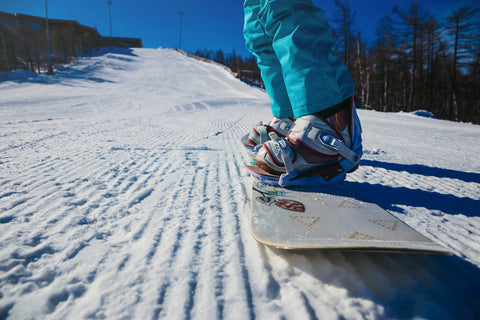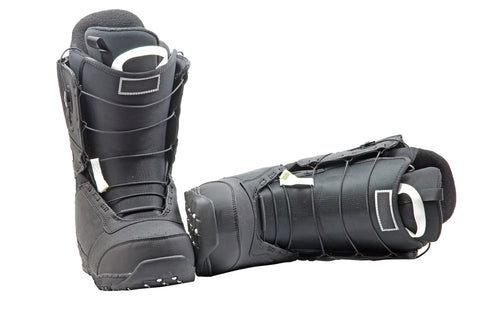It is important that your snowboard boots fit snugly in your snowboard bindings. If your boots are too loose, you run the risk of your foot coming out of the binding while you are riding, which could lead to serious injury.
If your boots are too tight, it will be uncomfortable and make it difficult to move your feet.
The best way to find the right fit is to try on different boots and bindings and adjust the straps until you find a combination that feels good.
How to Fit Your Boots in Snowboard Bindings
When you buy a new pair of snowboard boots, you need to make sure they fit properly in your bindings.
Here are a few tips on how to do that.
- First, check to see if your boots are the right size for your bindings. If they're too big or too small, they won't fit properly.
- Once you've determined that your boots are the right size, it's time to put them in your bindings. Start by putting the toe of the boot into the binding, then secure the heel.
-
Make sure the bindings are tight enough that your foot doesn't move around inside the boot, but not so tight that it's uncomfortable.

Try On Different Boots and Bindings
There are a few things to consider when it comes to how your snowboard boots should fit in your bindings. First, you'll want to make sure that you try on different boots and bindings to see what is the most comfortable for you.
You'll also want to make sure that the bindings are compatible with the boots that you have.
Lastly, you'll want to make sure that the bindings fit snugly around your boots so that you don't have any slippage while you're riding. When you're trying on different boots and bindings, it's important to pay attention to how they fit and how comfortable they are.
You should also make sure that the bindings are compatible with the boots that you're using.
Adjust the Bindings
When you buy a new pair of snowboard boots for women, it is important to make sure they fit properly in your bindings. If they are too loose, you will not be able to control your snowboard as well and may fall. If they are too tight, you will not be able to move your feet and may get very sore. The best way to adjust your bindings is to first put your snowboard boots on. Then, stand on your snowboard and lean forward so that your weight is evenly distributed. You should be able to wiggle your toes. Next, tighten the straps on your bindings so that your feet are secure, but not too tight. You should still be able to move your feet.
How to Know if Your Boots Fit in Your Binding?
When you are shopping for new snowboard boots, it is important to make sure that they will fit properly in your bindings. There are a few things that you can do to ensure a good fit. First, take a look at the bindings` toe and heel cups. They should be big enough to accommodate your boot's toe and heel without being too loose.
There should also be enough room for your boot's laces. Next, put the binding on your snowboard and tighten the straps. Then, put your boot in the binding and wiggle it around a bit. The boot should not move too much, but it should also not be too tight.
Conclusion
There are a few things to keep in mind when it comes to how your snowboard boots should fit in your bindings. First, you want to make sure that your boots are compatible with the bindings. Second, you want to make sure that the bindings are the right size for your boots. And finally, you want to make sure that the bindings are adjusted correctly so that your boots fit snugly and securely.
People Also Ask
Should boots hang over bindings?
When it comes to snowboards, it is generally accepted that the boots should hang over the bindings. This is because it provides more control and stability when riding. Some people, however, prefer to have their boots flush with the bindings.
This is a matter of personal preference and there is no right or wrong answer. Ultimately, it is up to the rider to decide what feels best for them.
How far should snowboard boots hang over bindings?
This is a question that often plagues snowboarders. How far should snowboard boots hang over bindings? The answer is not as cut and dry as one might think. It really depends on personal preference and what type of riding you plan on doing. If you're just starting out, it's probably best to have your boots hang over the bindings by about an inch or so.
This will give you more control and stability while you're learning the ropes. As you become more comfortable and confident on the slopes, you can start to play around with different boot / binding setups. Some riders prefer to have their boots flush with the bindings, while others like a little bit of overhang.

Should boots be centered on a snowboard?
There are two schools of thought when it comes to positioning your boots on a snowboard. Some riders prefer to have their boots centered on the board, while others like to have them positioned slightly toward the nose or tail.
There isn't necessarily a right or wrong answer, and ultimately it comes down to personal preference. That being said, there are a few things to keep in mind when making your decision.
For example, having your boots centered can help with balance and stability, while positioning them slightly forward can give you more control when riding. Ultimately, it's up to you to experiment and see what works best for you.
Can snowboard boots be too big for bindings?
Most snowboard boots are designed to fit a wide range of bindings, but there are some cases where the boots can be too big. This can cause the binding to loosen and come off, which can be dangerous. If you're not sure if your boots will fit, it's best to ask a professional or buy a pair of bindings that are specifically designed for your boot size.
ABOUT THE AUTHOR
Fred Felton
Content Creator / Editor
Fred Felton is a copywriter, editor and social media specialist based in Durban, South Africa. He has over 20 years of experience in creating high end content. He has worked with some of the biggest brands in the world. Currently Fred specialises in the winter outdoors space, focussing on skiing and snowboarding. He is also a keynote speaker and has presented talks and workshops in South Africa.






